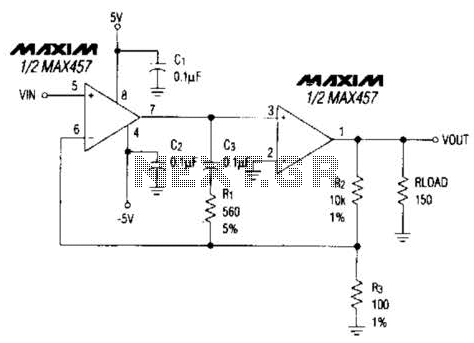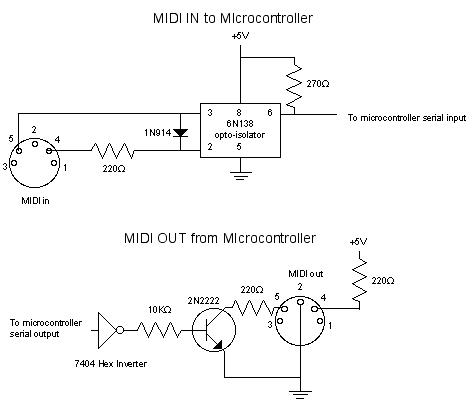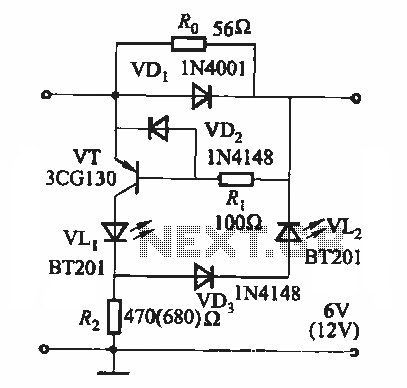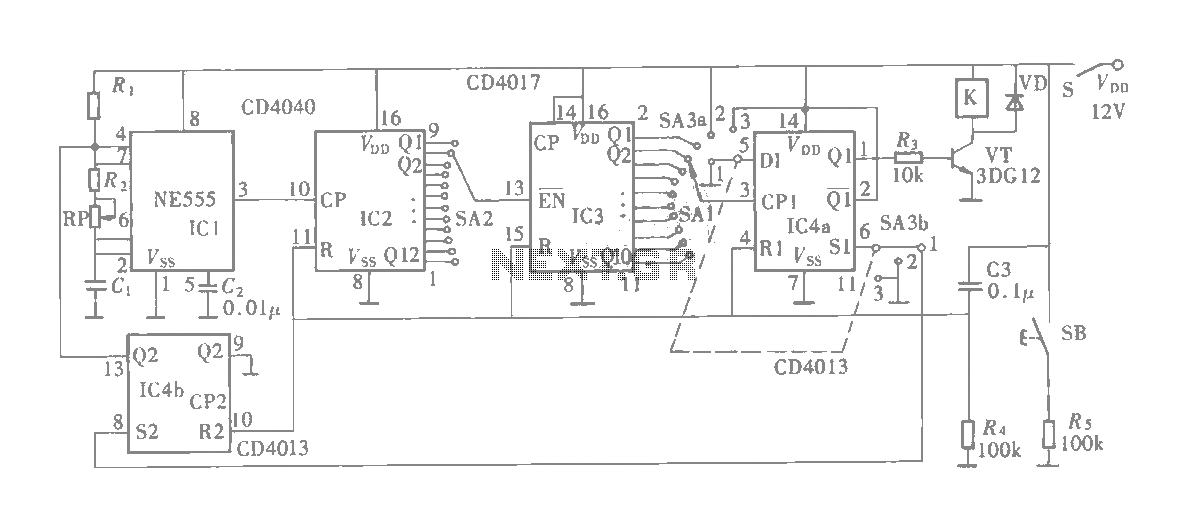
High Gbw Op-Amp Circuit

A composite amplifier can be constructed that offers high gain, wide bandwidth, and good DC accuracy by cascading the sections of a dual video amplifier and incorporating two suitable phase compensation components. The operational amplifier drives a 150-ohm load and delivers a closed-loop gain of 40 dB.
The composite amplifier design utilizes a dual video amplifier configuration to achieve enhanced performance characteristics. By cascading the amplifier sections, the overall gain is increased while maintaining stability and bandwidth. The inclusion of phase compensation components is crucial for ensuring that the amplifier remains stable across its operational frequency range, preventing issues such as oscillation or distortion.
In this configuration, the operational amplifier is designed to drive a 150-ohm load, which is typical for video applications. The closed-loop gain of 40 dB indicates that the output voltage will be 100 times greater than the input voltage, allowing for significant amplification of weak signals. This high gain is particularly beneficial in applications requiring the processing of low-level video signals, where maintaining signal integrity is essential.
The phase compensation components, often implemented as capacitors or resistors, are strategically placed within the circuit to adjust the phase response of the amplifier. This adjustment helps to mitigate any potential phase shifts that could lead to instability, particularly at higher frequencies. It is important to select these components carefully to match the specific characteristics of the amplifier sections being used.
Overall, this composite amplifier design is well-suited for applications in video processing and other scenarios where high fidelity and accurate signal amplification are required. The combination of high gain, wide bandwidth, and effective phase compensation makes it a robust choice for demanding electronic systems. You can build a composite amplifier featuring high gain, wide bandwidth, and good dc accuracy by cascading the sections of a dual video amplifier and adding two appropriate phase-compen-sation components. The op amp drives a 150- load and provides a closed-loop gain of 40 dB.
The composite amplifier design utilizes a dual video amplifier configuration to achieve enhanced performance characteristics. By cascading the amplifier sections, the overall gain is increased while maintaining stability and bandwidth. The inclusion of phase compensation components is crucial for ensuring that the amplifier remains stable across its operational frequency range, preventing issues such as oscillation or distortion.
In this configuration, the operational amplifier is designed to drive a 150-ohm load, which is typical for video applications. The closed-loop gain of 40 dB indicates that the output voltage will be 100 times greater than the input voltage, allowing for significant amplification of weak signals. This high gain is particularly beneficial in applications requiring the processing of low-level video signals, where maintaining signal integrity is essential.
The phase compensation components, often implemented as capacitors or resistors, are strategically placed within the circuit to adjust the phase response of the amplifier. This adjustment helps to mitigate any potential phase shifts that could lead to instability, particularly at higher frequencies. It is important to select these components carefully to match the specific characteristics of the amplifier sections being used.
Overall, this composite amplifier design is well-suited for applications in video processing and other scenarios where high fidelity and accurate signal amplification are required. The combination of high gain, wide bandwidth, and effective phase compensation makes it a robust choice for demanding electronic systems. You can build a composite amplifier featuring high gain, wide bandwidth, and good dc accuracy by cascading the sections of a dual video amplifier and adding two appropriate phase-compen-sation components. The op amp drives a 150- load and provides a closed-loop gain of 40 dB.





